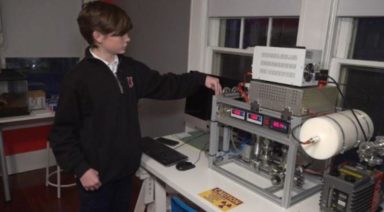Weather Modification Technology — Decades of Ever-Increasing Tempo

Weather Modification Technology – Good Idea or Bad? The Science of Playing God and an Overview of the Technologies
To what extent people are able to control the weather is a bit of a mystery to most. It has been a goal for ages, and perhaps could even be considered the “final frontier” in dominating and controlling Mother Nature. Despite fairly familiar terms such as “cloud seeding,” most believe that controlling the weather on a large scale cannot be done. Control a hurricane? Nonsense! Besides, the idea of controlling the weather with weather modification technology or weather changing machines is a bit alarming to most people. The sheer arrogance of such a proposal has the flavor of “playing God.”
Indeed, even at our technologically advanced state, the inner and outer workings of our planet still hold many mysteries. Have humans really advanced enough to actively manipulate this balance without harming or disrupting the overall planet? Of course, this harmony has been disrupted by climate change, the causes of which continue to spark heated debate. Regardless, with the growing concern over our changing climate, is it possible that weather modification technology could help?
Weather Control Technology — How is it Done?
Most weather control technology is based on some form of weather seeding, known more commonly as cloud seeding. Cloud seeding in its most basic form involves injecting salt, dry ice, silver iodide or other chemical particulates into clouds, either by ground generators or by airplane, to promote rainfall. Naturally forming raindrops appear in clouds when there is a presence of “condensation nuclei,” tiny particles that attract water condensation. Natural condensation nuclei vary; they can be salt from the ocean, soot from fires, soil from winds or other natural particles.
Cloud seeding technology accelerates the condensation process by introducing chemical particulates into the cloud, which stimulate and/or create “super nuclei.” Water condenses around the particulates, causing large droplets to form. Once the cloud has hit saturation point, the rain falls. Interestingly, cloud seeding can also be used as a method for preventing rain. Using more or less the same chemicals in different amounts, cloud seeding particulates can produce ice crystals that evaporate before hitting the ground, creating dry weather.
Despite decades of extensive studies, trials, and implementations, cloud seeding results are still fairly unpredictable. Undeterred, various cloud seeding methods have been researched and developed by atmospheric scientists for decades, and eagerly adopted and used by the U.S. military and entrepreneurs alike to manipulate weather for gain. Moreover, the cloud seeding model has been embraced by scientists worldwide as a springboard for developing other weather control technology.
Weather Modification Has Been Going On For Years
Almost from the start, scientists and weather control visionaries leapt from the idea of creating local rainfall to the goal of controlling storms and hurricanes. As far back as 1946, General Electric scientists wondered if cloud seeding methods might also work to control a hurricane by seeding dry ice and cooling temperatures in the eye.
Consequently, Project Cirrus was born, a joint venture between GE, the Office of Naval Research, and the U.S. Weather Bureau. In 1947 the Cape Sable hurricane was seeded with mixed results. The appearance of the clouds changed, and the hurricane itself abruptly changed direction and unexpectedly hit Georgia and South Carolina. Although the GE Scientists were initially held responsible for the resulting hurricane damage, it was determined later that an upper-level ridge was responsible for the turn and litigation was ended. Future legal threats did not stop the scientific community from continuing to research & conduct weather modification technology experiments. In fact, it is not out of the realm of possibilities that this may have been one reason why, from then on, weather modification programs assumed an extremely low profile.
The next decade or two saw many of these low-profile weather modification programs. In 1958, the US Navy quietly claimed the ability to create clouds and break them up using a “new cloud seeding technology” involving carbon black. Experiments conducted by US Navy scientists confirmed that when carbon black was sprayed into clear skies, clouds would form. Spraying liquid carbon black created long thin clouds up to a mile long. Dumping carbon black powder created large single clouds for each powder drop. If carbon black was sprayed into existing clouds, it would cause them to disperse.
In 1960, Project Skyfire began, the aim of which was to reduce the severity of lightning storms. A dispenser was developed that produced freezing nuclei by igniting a silver iodide solution in a propane flame. The Skyfire generators were mostly used on ground, but were also tried on aircraft with, once again, mixed results. At almost the same time, in 1961, a broad experiment called Project Skywater was initiated to study cloud seeding in different environments & at different times of the year, all across the nation.
Project StormFury came soon after, a joint venture between NOAA (the National Oceanic and Atmospheric Administration) and the US Navy that lasted two decades. From 1963 to 1983 controlling hurricanes was studied in earnest, with the goal of mitigating hurricanes and lessening the damage done, especially to the growing tourist and high end coastal communities. After two decades NOAA ended the program, stating that they were ultimately unable to “clearly ascertain whether or not the seeding efforts were really causing storms to weaken, or the systems just became victims of the environment around them”. However, the program yielded massive amounts of highly valuable weather data.

Almost Inevitable: Weather Warfare
During this time, laws were enacted requiring all weather modifications to be reported to the Federal Government via the Weather Modification Reporting Act of 1972. In 1976 the National Weather Modification Policy Act was put in place to authorize the creation of a national policy on weather modification. After all, the US Navy had been involved in weather modification programs since 1947 and had access to all that data. Apparently technology was progressing and the government wanted oversight. Then in 1978 the UN banned Weather Modification as a method of warfare with ENMOD (Prohibition of Military or Any Other Hostile Use of Environmental Modification Techniques). This was a move that begs the question, was a ban necessary to prohibit future implementation of weather modification as a method of warfare? Or as a result of destruction already seen?
It turns out that yes, using weather modification technology as a means of warfare had not escaped the imagination of the Military. From 1967 to 1972 Operation Popeye, a vast cloud seeding operation, had been responsible for the almost-constant rain during the Vietnam War. Operation Popeye’s weather warfare softened road surfaces, caused landslides along roadways, washed out river crossings and kept the Ho Chi Minh trails impassable with mud. Of course, it was denied at the time, until a memo was leaked and published. Top Secret congressional hearings were held. The truth of the matter came out, resulting in the creation of the above stated laws and eventually the ENMOD ban on weather warfare. Considering the nature of the U.S. military’s Top Secret programs, however, whether or not nations, including ours, are currently adhering to this ban is anyone’s guess.
Weather Experiments Get Spaced-Out
Aiming ever higher, and especially since the Space Race had begun, the 1960’s saw the first studies and experiments intended to increase understanding of the Earth’s magnetosphere. This, of course, included how the magnetosphere might be influencing weather and climate. Nuclear test explosions in the upper atmosphere that had been conducted in the 1950’s had created an artificial radiation belt that led to the discovery of the Van Allen Belts, layers of trapped radiation in the atmosphere. In an attempt to study the Belts, and the roles of the other layers of the magnetosphere, numerous “sounding rocket” or research rocket experiments began, in what could called “magnetospheric modification.” For the next decade or so, vapor, metal particulates and eventually plasma were released into upper atmospheric regions, creating artificial ion clouds within the various layers of the magnetosphere, which could then be studied.
Some of these experiments revealed that if the Ionosphere was heated, it could be used for global communication, space warfare (anti-satellite and ICBMs defense), climate control and terrestrial weather modification. It was theorized that ultrafine particle and condensation nuclei were being formed in the Ionosphere, which filtered down to become cloud condensation and ice nuclei, which in turn influenced cloud formation. Atmospheric scientists postulated that therefore, the manipulation of the upper atmosphere could influence terrestrial weather conditions. By 1978, many American scientists, as well as Dr. Andrew Michrowski of the Canadian State Department, agreed that there was evidence that the Soviets were pulsing Extremely Low Frequency (ELF) waves into the upper atmosphere, causing changes in the Jet Stream. In 1983, a dramatic shift in the Jet Stream caused the worst El Nino on record for 100 years.
Not long after, in 1990, funds were approved for HAARP (High Frequency Active Auroral Research Project). Based in Alaska, HAARP was, and still is, the largest Ionospheric heater in the country, although it’s ownership has changed hands several times. Originally run by the Air Force Research Laboratory and the Office of Naval Research, it served as both a research facility and a military facility enabling a more advanced understanding of the magnetosphere, and ultimately becoming a global communications center. However, considering the Soviet experiments, the U.S. military might have had more in mind than advancements in communication.
The HAARP array looks like a large field of antennae; the frequencies generated are projected high into the Ionosphere where they can be focused and directed anywhere in the world. A target of conspiracy theories, some claim that the frequencies generated by HAARP can be used for everything from creating earthquakes to mind control, as well as being a weaponized weather control machine. Indeed, in 1999 the European Parliament passed a resolution calling for more information on the environmental and health risks posed by HAARP, calling it a “global concern.” Scientists at HAARP dismissed the claim, asserting it was nothing more than a “radio science research facility”. However, concerns over HAARP persisted, and it was shut down as a US Military facility in 2014 amid negative publicity. Its ownership was transferred to the University of Alaska Fairbanks, where university studies and experiments continue.
The Tempo Increases
Meanwhile, cloud seeding technology marched onwards. Scientists, like those at the Masdar Institute, began to research how to accelerate cloud seeding operations and make them more reliable with nanotechnology. Using nanotech to enhance cloud seeding particulates, the condensation process could potentially increase by orders of magnitude. Additionally, new “electric” rainmaking technology was developed using lasers and cloud ionizers.
Lasers are used in relay systems between satellites, receiver stations, processing centers and transmission units, which use the information gathered to create and direct laser-induced artificial lightning in clouds. Although effective in creating rainstorms, this technology was suspected of essentially being a weather control satellite, and criticized for enabling weather warfare via bolts of lightning that could literally strike down an enemy. Cloud ionizers are weather control machines that involve fields of antennae that generate negative ions. The negative ions attach themselves to the rain nuclei, prolonging the life of the nuclei, either enabling rainfall or increasing it.
Another technology developed during this time, by a company called Aquiess, was resonance and frequency based. Using sensors to probe atmospheric conditions, frequencies could be deployed into storm systems that could interact with the frequency dynamics of the storm, and among other things, adjust the flight paths of the weather system. In 2011, Aquiess’s RAINAID Project offered its technology to mitigate African drought and brought much needed rain to the area. As beneficial as all this sounds, it would be naive to think that these technologies did not also present weather warfare opportunities, despite the ENMOD ban.
Weather Modification Finds a PR Source
At the turn of the millennium, climate change was becoming more and more of a concern. In 2015, the UN convened for the first Climate Change Conference and negotiated “The Paris Accord,” the first global agreement on the reduction of global warming. In 2016, 174 countries signed the agreement. Climate change data and information offered to the public placed the blame squarely on rising carbon dioxide emissions, and ignored other possible (man-made) contributing factors. However the decades of past, and still occurring, weather experiments over our heads, filling our skies and disrupting the magnetosphere should not necessarily be uniformly dismissed as irrelevant when considering our climate-gone-haywire as the new normal.
Weather modification is a true “elephant in the room” regarding climate change. Massive, intrusive, and in some cases dubious modification projects are currently taking place in our skies and atmosphere under the heading of “Climate Change Mediation”. Weather modification has emerged from the shadows rebranded as geoengineering, also known as Climate Engineering or Climate Intervention. Some of the current geoengineering projects include Solar Radiation Management (SRM), Stratospheric Aerosol Injection, Marine Cloud Brightening, Thermal Radiation Management and Short Wave Climate Engineering. Amazingly, in an ironic twist of fate, the technologies that may have been causing the climate change problem to begin with, are now being called on to fix it. Sadly, most experts agree that at this juncture, climate crisis cannot be averted without the implementation of SRM and other geoengineering technologies.
Blue Skies Ahead?
It’s a sunny day, and the skies are a deep, beautiful blue. As the day progresses, contrails begin to appear in the sky, as jets go by. The observant person, however, notices that some of these contrails don’t fade, but instead widen and become clouds. Pretty soon the sunny day has turned overcast. And more often than not, the next day the weather abruptly changes. Another name for these persistent and cloud-forming contrails is “chemtrails,” a puzzling and troublesome phenomenon because of the lack of any official recognition or explanation of them. However, chemtrails are a form of geoengineering, and an example how weather modification technology has entered our daily lives. Geoengineering is happening every day right over our heads, and seems to have become an enormous and pervasive thing while we were sleeping. Whether we continue to let atmospheric scientists and the military call the shots from their ivory towers, or demand to become more readily informed or involved, is up to us.
Electrogravitics: Antigravity, Tesla, and a Military Cover-Up

Electrogravitics can be traced to Nikola Tesla’s work with high-voltage discharges in the late 1800s. When Thomas Townsend Brown discovered that electrostatic and gravitational fields are closely intertwined, the world changed.
In astronomical terms, gravity dominates nuclear and electromagnetic forces, which, if implemented into relatable, Earth-based technologies, would create economic and scientific paradigm shifts.
There have been thousands of attempts to produce measurable and scalable “antigravity,” a futuristic tech that theoretically produces unlimited energy for use in propulsion and other categories of technology.
Key government officials have said that the military has used antigravity tech for years. While conspiracy theorists love the subject, some say antigravity talk is cheap and comprised entirely of untested hype.
The innovative suppositions and theories in electrogravitics and electrokinetics, the base concepts for antigravity, point to the potential for tremendous technological advances. Put quite simply if you test these theories with natural progressions, the probable advances in transportation and military technologies could transform human life as we know it.
“At no time, when the astronauts were in space were they alone: there was a constant surveillance by UFOs.”
— Astronaut Scott Carpenter referring to a UFO he photographed while in orbit on May 24, 1962. NASA still has not released the photograph.





































